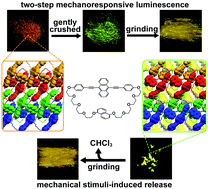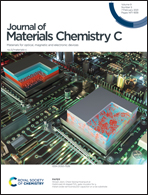Two-step mechanoresponsive luminescence and mechanical stimuli-induced release of small molecules exhibited by a luminescent cyclophane†
Abstract
Achieving multiple mechanoresponsive luminescence-related functions from a single molecule remains challenging. Here, we demonstrate that both two-step mechanoresponsive luminescence and the release of small guest molecules are achieved by a 9,10-bis(phenylethynyl)anthracene-based cyclophane. When gently crushed, the yellow-emissive crystal of the cyclophane exhibits a hypsochromic shift of the emission band, because of alterations in molecular packing at the surface. Subsequent grinding results in a bathochromic shift of the emission band due to excimer formation accompanying the transition from the crystalline state to an amorphous state. Another pseudopolymorph of the cyclophane exhibits the release of chloroform from its crystal structure in response to mechanical stimuli, accompanied by a photoluminescent color change from yellow-green to yellow. These results reveal that luminescent cyclophanes are promising candidates for creating sophisticated mechanoresponsive luminescent materials.



 Please wait while we load your content...
Please wait while we load your content...